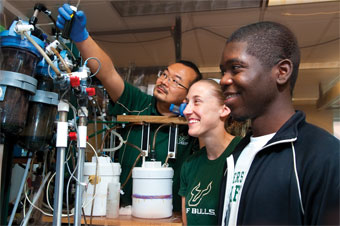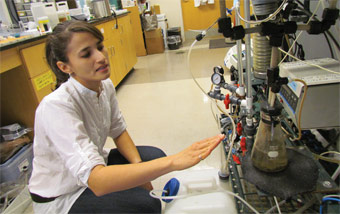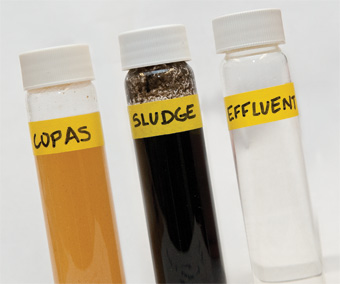Feature
Sustainable Science
| USF News

Yeh, left, works with graduate student Ivy Cormier and undergrad Herby Jean on the NEWgenerator.™ "Students build the machine," he explains. "We use innovation as a vehicle to build STEM capacity."
Photo by Aimee Blodgett | USF News
For Daniel Yeh, there are some unvarnished facts about life on Earth that need addressing.
First, there are 7 billion people who live here. They need clean water to grow food, and energy to power their communities.
And another fact about those 7 billion people: they all poop.
So what if you could take some of the things humans really need — such as clean water and energy — and harvest those things from the one thing everybody has to do?
That's exactly what Yeh, USF Associate Professor of Civil and Environmental Engineering, has done.
In November, the Bill & Melinda Gates Foundation awarded Yeh a $100,000 Grand Challenges Explorations grant to support his innovative anaerobic membrane bioreactor, trademarked as the NEWgenerator.™
The project is one of 110 projects in six categories selected for support from the Gates Challenges fund, designed specifically for researchers to explore unconventional ideas that could solve persistent global health and development challenges.

Former student Ana Prieto, at work on the NEWgenerator,™ earned her PhD while working in Yeh's lab. Her research landed her a postdoc position at a new National Science Foundation Engineering Research Center focused on water.
Photo by Vickie Chachere | USF News
Yeh will use the grant to develop a prototype device that, once linked into a waste collection system, will convert human waste into water that has been thoroughly cleaned of pathogens and is suitable for crop irrigation or household uses. The process, which uses microbes to break down waste, also produces methane gas which can be captured and used for heating and as a clean energy source.
With the world's clean water supply reaching a crisis-level in depletion, many experts acknowledge that using potable water for uses other than drinking is simply a waste of a dwindling resource and new solutions are needed. Yeh's system is relatively inexpensive, doesn't consume much energy and doesn't leave much byproduct.
In Yeh's lab, a small version of the NEWgenerator™ has been built and perfected over more than four years. The "waste" matter used to test the machine's isn't what you might think; for the experimental stage, Yeh uses dry cat food soaked in water which mimics the properties of human waste.
"The dirtier the better," Yeh explains of the raw matter going into the machine. "The more polluted it is, the more methane we can recover."

Samples from Yeh's lab illustrate how dirty water becomes clean water as it is processed by the NEWgenerator.™
Photo by Aimee Blodgett | USF News
Yeh's system differs from current wastewater treatment plants which use aerobic microbes to breakdown wastes. Those systems require more energy to run and leave considerable sludge byproduct. His project also is intended for a much smaller scale than large centralized systems which are expensive for communities to construct.
"I keep going back to the fact there are 7 billion people on the planet," says Yeh, citing the milestone the world's population passed late last year. "It's kind of a wake-up call.
"How are we going to make enough food? Where's the energy going to come from? We have to stop having everything being a one-way street. We need to close the loop."